The Sony Xperia 1 Review: A 21:9 Take of the World
by Andrei Frumusanu on July 26, 2019 8:00 AM EST- Posted in
- Mobile
- Sony
- Smartphones
- Xperia 1
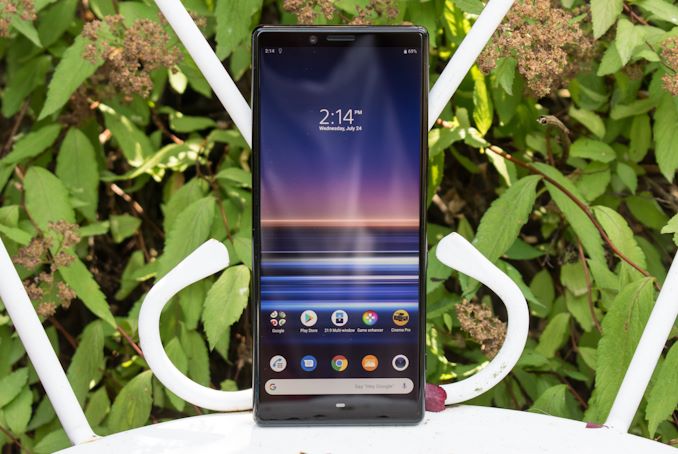
Sony is a company that we don’t talk nearly as much about as one would expect when it comes to their smartphones. In fact, here at AnandTech we had the odd circumstances of never actually been able to review a Sony phone. Be it unfocused marketing on Sony’s part or just bad luck on our part, it was a coverage area we’ve been looking to address for some while now.
This year, after numerous quarters of financial losses of the division, Sony’s mobile group was in particular turmoil as the company division has been going through some major restructuring. The most major change is that the Xperia Mobile division has been now grouped into Sony’s TV, audio and camera product lines, ending its time where the group would operate completely independently from Sony’s other divisions. In a way, this is a good change; we’ve in particular seen statements from the company’s spokespersons that past Sony smartphones suffered from the disconnect to other company divisions, for example having to figure out camera processing on their own as the Alpha camera team would not be allowed to help the smartphone team.
We’ve met with Sony back at MWC earlier this year and had a preview of the new Xperia 1 in its earlier stages. The one thing that I took away from that meeting is that the mobile division is now a lot more hopeful and motivated under the new management, and the new Xperia 1 is the first phone that’s really been affected by the new reorganisation. In general, Sony is hoping to turn the page on several years of lacklustre success, and bring back the mobile division into form.
With the new Xperia 1 thus representing the first flagship device under the new organisation, it’s an incredibly important device for Sony, and a phone we didn’t want to miss out on reviewing. The phone is characterised by its unusual 21:9 screen aspect ratio on 4K OLED screen and a new triple-camera setup. Today, we’ll be putting the Xperia through our usual test suite and look if Sony has been able to deliver on its promises.
| Sony Xperia 1 | ||||
| Sony Xperia 1 | ||||
| SoC | Qualcomm Snapdragon 855 1x Kryo 485 (Cortex-A76) @ 2.84GHz 3x Kryo 485 (Cortex-A76) @ 2.42GHz 4x Kryo 485 (Cortex-A55) @ 1.80GHz Adreno 640 @ 585MHz |
|||
| DRAM | 6GB LPDDR4X | |||
| Display | 6.5" AMOLED 3840 x 1644 (21:9) HDR |
|||
| Size | Height | 167 mm | ||
| Width | 72 mm | |||
| Depth | 8.2 mm | |||
| Weight | 178 grams | |||
| Battery Capacity | 3330mAh 18W USB-PD Adaptive Charging |
|||
| Wireless Charging | - | |||
| Rear Cameras | ||||
| Main | 12MP 1.4µm Dual Pixel PDAF f/1.6 78° lens with OIS 960fps video recording |
|||
| Telephoto | 12MP 1.0µm f/2.4 45° 2x zoom with OIS |
|||
| Wide | 12MP 1.0µm f/2.4 130° fixed focus |
|||
| Extra | - | |||
| Front Camera | 8MP 1.12µm f/2.0 |
|||
| Storage | 128GB UFS 2.1 | |||
| I/O | USB-C no 3.5mm headphone jack |
|||
| Wireless (local) | 802.11ac Wave 2 Wi-Fi Bluetooth 5.0 LE + NFC |
|||
| IP Rating | IP65 & IP68 | |||
| Other Features | Dual Speakers | |||
| Dual-SIM | 1x nanoSIM + microSD or 2x nanoSIM |
|||
| Launch Price | $949 / £849 / €949 | |||
In terms of hardware specification, the new Xperia 1 is in line with most other flagships this generation and employs Qualcomm’s Snapdragon 855 SoC. We’ve covered the chip extensively over the past few months and the piece has impressed us with its speed and efficiency, and should represent a great foundation on which the new Xperia 1 can build upon.
Sony is equipping the phone with 6GB of RAM, whilst not quite as aggressive as some other vendors, is still plenty sufficient and enables an excellent multi-tasking experience. On the storage side of things the phone comes in a sole 128GB UFS 2.1 storage configuration, however Sony still offers a microSD slot which is something that is becoming a rarity nowadays.
Moving on to the obvious, the phone’s key feature is the new 21:9 OLED screen. It represents the Xperia 1’s defining characteristic which makes it stand out from all other phones in the market. Although the screen is 6.5” in diagonal, as with other phones these past few years, the metric doesn’t really mean much anymore in terms of it defining a phone’s size. So even though the diagonal sounds a bit scary at first, due to the 21:9 aspect ratio, the Xperia 1 is still only 72mm wide, which is smaller than other “plus” sized devices in the market, and the phone is in fact smaller than say a Galaxy S10+.
Sony I think nailed the form-factor and I do greatly enjoy the size as for me it falls into the sweet-spot between screen real-estate and one-handed usability and ergonomics. Of course, this is also quite a long phone, so while its width can be narrower than most of the competition, it’s absolutely longer than any other mainstream devices out there with a very height of 167mm.
Sony’s rationale for the 21:9 aspect ratio lies mainly in viewing 21:9 video content, however I found this to play second fiddle to the actual benefit: more vertical content space in your web-pages and applications. While yes there are very much benefits to viewing native 21:9 movie content on the device, I still think most consumer video content will be staying at 16:9 for the foreseeable future. Here I had wished Sony’s marketing had put a bit more focus on the more important benefit of having more content in vertical mode.
The display’s design is relatively straightforward, but that’s not really a bad thing. There’s no notch and the bezels aren’t exactly ground-breaking either, but for some people this can also be a benefit as there’s also no distracting screen cut-outs and the flat display doesn’t add additional reflections as seen in other recent curved screen devices.
The screen itself is also one of marvel: It’s a 4K (3840 x 1644) resolution OLED which, while not the first 4K display phone, is the first OLED of its kind in a consumer device. Sony makes some big claims about its capabilities in regards to HDR and colour spaces, some of which do pan out while others aren’t quite as honest. The one big thing that I do need to mention here in the intro is that Sony is a bit misleading as to the 4K resolution. While the panel is indeed 4K, only certain media content such as the native photos gallery app as well as video playback in some applications is in fact rendered in 4K, as the default software rendering for most other applications happens at 1440p. It’s something we’ll address later on, but it’s something one should be aware of from the start.
The “forehead” of the device is small. The right side doesn’t contain much as it lies over the SIM tray, but the left side is filled with the usual sensors as well as the front camera. There’s also a notification light – odd that I have to mention this, but I do miss the feature on other recent devices. What I’m not too sure about is Sony’s design of the earpiece; it’s quite recessed at over 1mm in the front-glass cut-out, and while it has a very fine mesh/membrane protecting it, I can see that it’ll be a dust collector over time.
The rear of the phone is characterised by its triple-camera setup. Sony opted for a vertical layout, which works well for the elongated phone. The cameras are triple 12MP units. The main sensor is a full dual-pixel PDAF design with 1.4µm pixels, and features a f/1.6 lens with OIS. The telephoto and wide-angle sensors are of 1.0µm pixel pitches and both have f/2.4 aperture lenses. The 2x zoom module’s viewing angle is 45° (78° on the main camera), while the wide-angle is a very wide 130°. The wide-angle is of a fixed focus design with no OIS, while the telephoto unit does have OIS.
Unlike the front of the phone, the back glass is slightly curved on its sides which, together with the round frame design of the phone, gives it quite nice ergonomics even though at first glance the phone might mistakenly appear quite boxy.
The weight of the phone is also kept in check at 178g. Although the weight and the phone’s 8.2mm thickness, Sony only managed to employ a 3330mAh battery into the phone whilst other vendors have managed to cram in 4000mAh units in similar form-factors, and this is definitely one of the phone’s weak-points in terms of the hardware design.
Sony’s SIM tray design is quite unique in that it doesn’t need an ejector tool. You can just use your fingernail to pull the cover and pull the tray. I’m still a bit paranoid about accidental prying open the tray (Particularly for an IP68 phone), but it does feel well designed and robust.
The left side of the phone is barren of buttons as they’re all located on the right side. Here we find a volume rocker, a fingerprint sensor, power button and a dedicated camera button.
The fingerprint sensor is good, although I wasn’t too impressed with the unlock speed. The issue here isn’t the fingerprint itself as it does seem it’s able to recognize it quite fast as demonstrated by the vibration feedback, but the screen turns on just a bit later than that, which I found a bit slow. The phone can be woken up by double-tap to wake, the fingerprint sensor, the power button, or with the camera button. Interestingly enough you don’t need to unlock the phone when waking it with the camera button and you’re free to take pictures or videos like this – however you’re sandboxed and can only view content during that session.
The camera button is also a two-stage button, pressing it lightly in the camera app is akin to focusing, and pressing it fully will capture a photo/video.
On the bottom of the phone we find the USB-C port and the main speaker grill, which by the way along with the earpiece speaker are able to play back in stereo. What’s obviously missing here is the 3.5mm headphone jack, and it is quite the travesty of Sony to abandon it. Sony had a promotion bundle of offering the Xperia 1 with one of its own wireless headsets, so I think the company has fallen prey to the anti-consumer move of attempting to gain profits by trying to sell accessories on top of its devices. The phone still offers a 3.5mm dongle adapter, and the kicker is the included headphones are 3.5mm themselves.
Overall, I liked the Xperia 1’s hardware design. The elongated aspect ratio was something fresh, and in general the device’s ergonomics are excellent in my subjective view. The phone still managed to somewhat continue Sony’s Xperia industrial design, yet also evolves it into a different direction that is quite enjoyable.


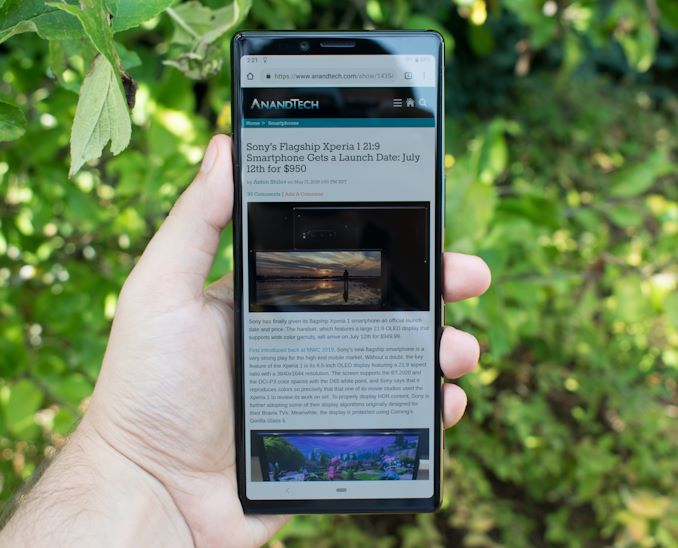
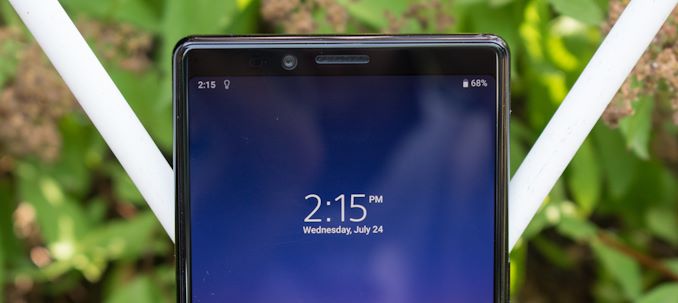
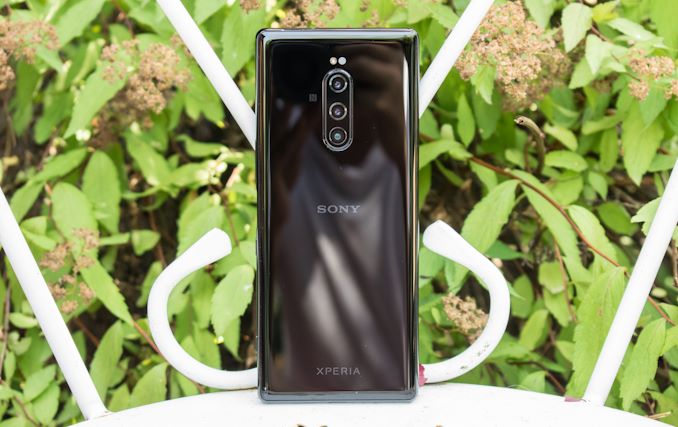
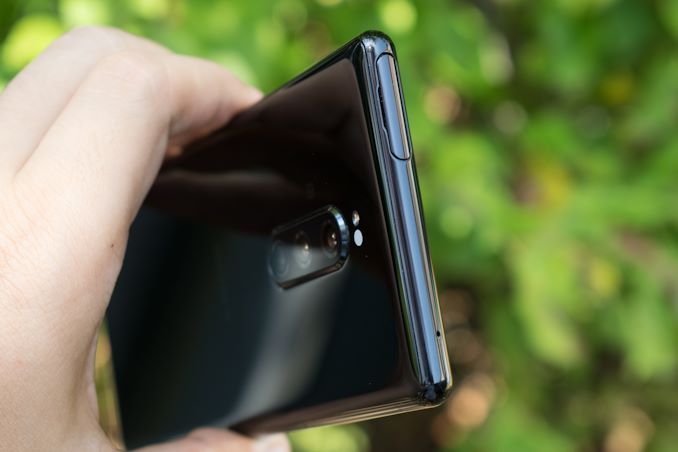
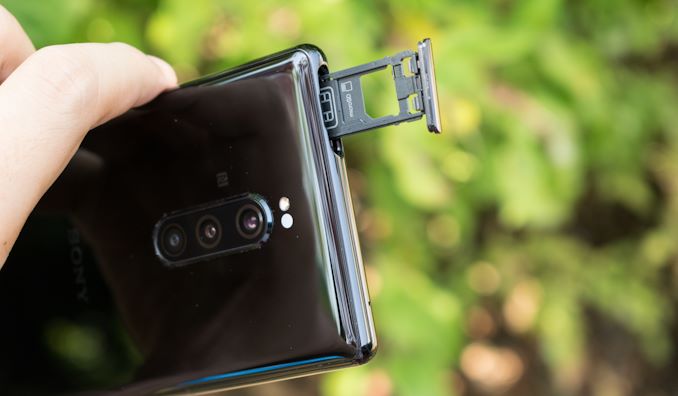
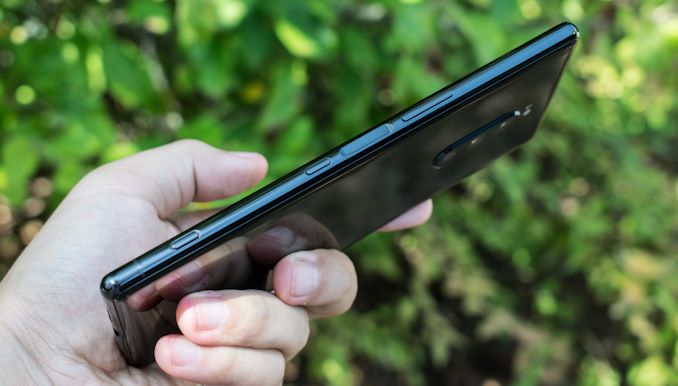









75 Comments
View All Comments
flyingpants265 - Monday, July 29, 2019 - link
You know, they could just make a phone with all the features people want. In all sizes. Why don't you ask for that instead?Front speakers, 5000mAh battery, fast wireless charging, waterproofing that actually works, usb-c/audio jack, in-screen fingerprint reader that works properly, under-screen camera. 5", 5.6" and 6.2" options.
16:9 or 17:9 screen, no ridiculous screens that are the size of a TV remote. MicroSD would be nice, but I'd be willing to sacrifice it if we got cheap 128gb/256gb options.
HJr. - Tuesday, July 30, 2019 - link
Congratulations you describe Galaxy S10!inperfectdarkness - Sunday, August 18, 2019 - link
I have an Xperia XZ2 Compact and I love it. That said, yes, the only compelling reason to buy Sony was for a smartphone that wasn't actually a phablet. I do miss the 3.5mm jack. I can survive w/o wireless charging; and that's really the one and only thing I had to give up over the full size XZ2. Honestly, the Z3 compact was only a smidgen smaller than the XZ2 (127.3 x 64.9 x 8.6 mm for the Z3 compact vs. 135 x 65 x 12.1 mm for the XZ2 compact).My XZ2 will have to be pried from my cold dead hands. It truly is the last of the flagship-level "compact" smartphones.
abufrejoval - Friday, July 26, 2019 - link
I’ve been close to buying a Sony device some years ago, Snapdragon 800 generation when they had a thinner and bigger competitor to the Galaxy Note, I believe and I generally value them as a great engineering company.Betting on this form factor is obviously a risk: If they find enough fans in that niche as well as the compact one, I’d be happy to see them survive.
I may watch a small video here and there on a phone, but watching a full-length movie on that screen would only work for me if you could fit it into a headset, like Google Cardboard or LeEco LeVR: The Sony screen seems to have a good enough resolution to make that attractive e.g. for a longer plane ride. Any idea on if such a device is working/available for this Sony?
My major smartphone usage is reading and browsing so actually I could be more easily tempted by a 16:10 (like the original Galaxy Note) or 3:2 device (another niche, Sony!).
And at that price it requires a fully functioning desktop replacement mode with Ethernet and a 4k monitor available via a docking station as well as properly managed DPI adaptations for OS and apps at dock/undock to work out economically.
Another issue with Sony phone has been that I prefer custom ROMs in general, and Sony devices tend to lose a lot of their photo/video capabilities on AOSP.
I was surprised to see a Czech/French dictionary (and more Czech books) in your library: I would have guessed that your mother tongue was Rumanian and that in Luxembourg you’ll have to manage with French, Germany and Lëtzebuergesch as well as English.
Some commentators here don’t appreciate that when you deal with four languages or more on a daily base, certain errors tend to creep in. I manage German, English, Spanish and French pretty much every day and towards the evening or with current temperatures all can deteriorate to a point just short of mumbo jumbo.
GlossGhost - Sunday, July 28, 2019 - link
If you think Sony have it bad with custom ROM's, try Samsung. You literally get dogshit camera quality, no hardware acceleration (at least on the Exynos model), no Always On Display and probably many of the framework boosters.abufrejoval - Tuesday, July 30, 2019 - link
The custom ROM situation is only getting worse, because vendors need you to buy a new device regularly: Their temptation to boycott is easy to understand and completely intolerable.My Samsung Note 3 followed a Note (1) and that the initial i9000 that made Jobs lose it.
They all still work thanks to replacable batteries and custom ROMs.
The Note 3 is stilly actually still used regularly (runs Pie) as a backup device on my fairly regular business trips across the EU.
Screen protectors, silicon protection cases and a plastic body have kept them look like new, despite various drops on streets not always dry or clean.
Everything Samsung delivered since, was just plain nonsense, badly overpriced or putting corporate interests so much before customers (Exynos), that it hurts: I travel internationally and want a global phone, even if I live mostly in Europe. Geographic market segmentation is so anti mobile they might as well sell them with a cable.
I got a LeEco Le Max2 next (also still active) and can't see any reason to upgrade beyond my current OnePlus 5 (finally a phone so efficient, I totally lost my battery anxiety), rather unfortunately really, because I really like playing with toys with new features. Those three run on linked corporate SIMs with global roaming and with identical apps and launchers, so I can switch between them very seamlessly. Haven't bothered with hotel or public Wifi in years, none come even close to the ~100Mbit LTE data rates tend to get, at least in Europe. 5G? Can't quite imagine why I'd need it any time soon.
Unfortunately, mobile phones develop only features I cannot appreciate or even dislike (rounded screens, glass/metal cases), yet none of those I'd consider valuable (good desktop mode with 4K monitor and cable Ethernet for Wifi-less office use).
So I need to spend my play-money on new toys like the DJI Robomaster, except that for some reason they don't sell it in Europe yet... Nobody wants to sell me what I want!
Is that the new way of selling more? Making sure you never get what you want so you'll have to keep on buying?
philehidiot - Sunday, July 28, 2019 - link
On the ISS they use Runglish or something, which is the blend of Russian and English that just developed on the station due to constantly flipping between languages.sonny73n - Friday, July 26, 2019 - link
AT, Sony experia isn’t worth our time. Give us something else, anything!Teckk - Friday, July 26, 2019 - link
Not sure if the width is enough looks lil weird. For that price - the battery capacity and RAM (compared to other phones) and seems to be relatively less.Arbie - Friday, July 26, 2019 - link
A media machine with no headphone jack. Smart.